#witch hunts
Text
Is the spiritual person a conspiracy theorist? A list of red flags
They talk about a shadowy group of people supposedly manipulating everything behind the scenes. They might refer to them by terms such as globalists, bankers, international bankers, secret rulers of the world, the elite, the cabal, Kabbalists, Talmudists, satanists, satanic pedophiles, pedophiles, generational satanists, satanic bloodlines, the Illuminati, the Babylonian Brotherhood, lizard people, Reptilians, Orions, regressives, regressive entities, Khazarians, Marxists, cultural Marxists, or leftists. Sometimes, very rarely, they'll just come right out and say "Jews."
They claim that the conspiracy has been working to conceal historical and spiritual truths from humanity.
They claim that the conspiracy uses stuff like food, entertainment, and medicine to control the masses. For example, "additives in food suppress our psychic abilities" or "Hollywood films contain subliminal messages" or "COVID vaccines were actually created to alter your DNA to make you more docile."
Also, claims that the conspiracy controls people via spiritual or technological implants, 5G, or alter programming, with or without explicit mention of Project Monarch (a conspiracy theory promoted by far right cranks such as Mark Philips and Fritz Springmeier, who used hypnosis to respectively convince Cathy O'Brien and Cisco Wheeler that they'd been put under mind control by a global satanic conspiracy).
They claim that this conspiracy is controlling the media, has fingers in every institution they disagree with, and is generally behind everything they disagree with. (EG, the conspiracy created the Catholic Church; that other New Ager they disagree with is actually controlled opposition, etc.)
They claim that the conspiracy is trying to keep people in fear.
They claim that the conspiracy harvests something from people. Blood and adrenochrome are common ones. Loosh is somewhat less common. Expect to see something else pop up eventually.
They claim that the conspiracy practices genetic engineering; EG, creating animal/human hybrids, using vaccines to genetically sever people's connection to God, etc.
They claim that true spiritual wisdom can be traced back to places like Atlantis, Lemuria, or Mu.
They claim that world governments have secretly been in contact with extraterrestrials for years.
They appeal to known frauds and cranks, including but not limited to Erich Von Daniken, Zechariah Sitchin, David Icke, David Wilcock, Graham Hancock, Jaime Maussan, Bob Lazar, Steven Greer, Richard C. Hoagland, Fritz Springmeier, and Drunvalo Melchizedek.
Appeals to forged documents, including but not limited to the alleged diary of Admiral Richard Byrd, The Emerald Tablets of Thoth the Atlantean, and The Urantia Book.
Appeals to channeled information, such as that provided by Edgar Cayce, Carla Rueckert, or George Van Tassel.
"But all of this has to come from somewhere, doesn't it?"
Oh, it all comes from somewhere, all right, but the where isn't what most people imagine.
A lot of the stuff above is just a modern spin on the content of The Protocols of the Learned Elders of Zion, a Russian hoax created to justify violence against Russian Jews. The Protocols itself was plagiarized from a political satire and incorporated a lot of the post-French Revolution conspiracy theories about Freemasons and Jews being behind the French Revolution. I wrote a summary of the conspiracy tropes found in The Protocols over here.
The stuff about Satanic sacrifices and the consumption of blood, adrenochrome, loosh, or whatever are simply just variations on blood libel, an antisemitic conspiracy theory that claims Jews practice ritual cannibalism. Blood libel can be traced back to ancient Greece. (With the Greek version, I really can't help but notice the similarity to modern urban legends of gangsters kidnapping random people for initiation rituals.)
Many of these tropes can also be linked back to the early modern witch hunts. It was believed that witches sacrificed babies to Satan, practiced cannibalism, and put people under mind control by way of diabolical magic. It was also believed that some witches didn't even know they were witches; they'd go off to attend the Devil's Sabbath at night and come back in the morning without remembering a thing. In the late 20th century, this witch hunter's canard would be reinvented as the alter programming conspiracy theory when media such as the 1973 book Sibyl and its 1976 television adaptation put DID (note: the woman who inspired Sibyl did not have DID) into the public consciousness. For a more complete list of witch panic and blood libel tropes, I wrote a list over here.
Lemuria was a hypothetical landmass proposed to explain the presence of lemur fossils in Madagascar and India while being absent in continental Africa and the rest of Asia, because if lemurs evolved naturally, they wouldn't be in two separate places with no connection to each other. The discovery that India and Madagascar were once connected not only made the hypothesis obsolete, it precludes the existence of Lemuria.
The whole notion of Mu began with a horrendous mistranslation of the Troano manuscript. A man named Augustus Le Plongeon would link the mistranslation with the story of Atlantis, and use it to claim that Atlantis actually existed in the Americas. (For Plongeon, Mu and Atlantis were one and the same.) And then other people (like James Churchward) got their hands on the whole Mu thing, and put their own spins on it, and the rest is history.
Le Plongeon's ideas influence modern Atlantis mythology today; EG, the idea that it was in the Americas. Another guy who helped shape the modern Atlantis myth was Ignatius L. Donnelly, an American politician. Dude claimed that Atlanteans spread their oh-so-superior culture far and wide. He also claimed that Atlantis was the home of the Aryan people, because of course he did.
The idea that all of the world's wisdom can be traced back to Thoth/Hermes goes back to Hermeticism, a product of Greco-Egyptian syncretism. Hermeticism produced a fascinating body of mythology and an interesting way to consider the divine and its role in shaping human history, but that doesn't mean it was right. And the Emerald Tablets of Thoth the Atlantean is a modern text that has fuck-all to do with ancient Hermeticism and more to do with HP Lovecraft.
This idea that the conspiracy uses pharmaceutical drugs and vaccines for evil also has roots in Nazi Germany. The Nazi government, wanting to reserve real medicine for their soldiers, told the general populace that said medicine was the product of evil Jewish science and prescribed alternative healing modalities instead. (Said alternative healing modalities did not particularly work.) It also echoes the old conspiracy theories about Jews spreading the Black Death by poisoning wells.
The idea that the conspiracy uses genetic manipulation to create subhuman beings or sever humanity from the divine is a permutation of the Nazi conspiracy theory that Jews are trying to destroy the white race through race mixing. The idea of evil reptilian DNA goes back to the ancient serpent seed doctrine, which is indeed old, but no less pure hateful nonsense for it.
"But there's got to be somebody up to something rotten out there!"
Oh sure. But these people aren't skulking around in the shadows. They're acting pretty openly.
The Heritage Foundation has been working to push this country into Christofascism since the early 1970's. They're the ones responsible for the rise of the Moral Majority and the election of Ronald Reagan. They're also the ones behind Project 2025, which intends to bring us deeper into Christofascism. (Among many other horrible things, they intend to outlaw trans people as "pornographic.")
The Seven Mountains Mandate is another movement pushing for Christofascism. They intend to seize the "seven spheres" of society, which include education, religion, family, business, government/military, arts/entertainment, and media.
There's also the ghoulish American Evangelicals who support Israel because they think that current events are going to bring about the Second Coming of Jesus and cement the formation of a global Christofascist empire. Don't let their apparent support of Jews fool you - they believe that the good Jews will become Christians and the bad ones will go to hell.
All of these people are working toward monstrously horrific goals, but none of them are part of an ancient megaconspiracy. In fact, these are the kinds of people pushing the myth of the ancient megaconspiracy. From the witch hunts to Nazi Germany to the American Evangelical movement, if history has taught us anything, the people pushing the conspiracy theories are always the bad guys.
#conspiracy theories#conspiracy theory#conspiracism#conspirituality#conspiracy theorists#conspiracy theorist#spirituality#spiritual community#red flag#red flags#spiritual red flags#spiritual red flag#atlantis#lemuria#antisemitism#witch hunts#history#pseudohistory#religion#witchblr#paganblr#occultblr#discernment
1K notes
·
View notes
Text
Hot take: the Wittebanes were not Puritans
So since Hollow Mind came out there have been a lot of jokes about how the Belos is a crusty old Puritan. And while he is certainly crusty and old, I don’t think he was a Puritan.
I understand why everyone jumps there, when we think of Witch Hunts in Colonial America the very first thing that comes to mind is the Salem Witchcraft Trials. However, the Salem Witchcraft Trials began in 1692, that is 80 years after Masha says the Wittebros showed up in Gravesfield, and 30 years after the events of Elsewhere and Elsewhen.

If Masha’s information is correct, (which it might not be but we’ll get to that) then Caleb and Philip arrived in Gravesfield in 1613, which is closer in time to the settlement of Jamestown (1607) than the Salem Witchcraft Trials.
The Pilgrims didn’t even land at pride rock until 1620, seven years after the Wittebros arrived in Gravesfield. The Mayflower Pilgrims were really the group responsible for creating the idea of religious charters. They specifically wanted to leave England to create their own religious society. Many other groups followed, (notably the Massachusetts Bay Colony, which later became the home of the aforementioned Salem Witchcraft Trials) but the Mayflower Pilgrims were the first group of religious extremists who came to America looking for their Zion.
Prior to that, the motivation to settle the “New World” was mainly financial. Ships were chartered through the Virginia Company. Which as we all remember from our favorite wildly inaccurate and problematic 90s Disney movie, the Virginia Company was in it for the money. The New World had resources and Britian wanted them, damnit, Glory, God, and Gold and the Virginia Company.
That meant, if Caleb and Philip really did arrive in Gravesfield in 1613, their family likely made the trip for financial gain, not religion. If that’s the case they were less likely a member of an obscure group of religious extremists, and more likely to be either Protestant like King James and Queen Elizabeth. (They could have also been Roman Catholic, evidence for that comes later).
“But”, you say, “weren’t Puritans the ones persecuting witches at the time?”
Yes and no.
In the Americas, Witch Hunts will forever be linked to Puritans, but in Witch Hunting long outdates the Puritans. King James himself, was a witch hunting fanatic, he personally oversaw hundreds of witchtrials. He wrote books about finding witches, and it was specifically the King James endorse translation of the Bible that features the infamous “thou shalt not suffer a witch to live” (in many prior translations the word witch is something more along the line of “sinner” or “evil doer”). By many estimates, upwards of 1500 people were executed for witchcraft as a result of his reign. If we are going with Masha’s 1613 timeline, the brothers would have left England smack dab in the middle of his reign, right after the King James Bible was published.

(^this GIF has nothing to do with the Owl House, I just love sassy Gay King James in his bird mask, look at this cocky ass bastard, you know him and Belos would have been genocide buddies)
However, I can’t pretend to be focused on some semblance of historical accuracy and take Masha’s information at face value, even in the context of the show it wouldn’t add up because according to the sign we see in Yesterday’s Lie, Gravesfield was established in 1635.
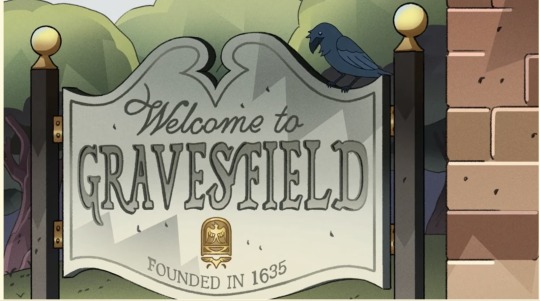
(Granted there is a difference between a settlement and a town, it is possible that 1635 was when Gravesfield was officially acknowledged as a town and the boys just lived there pre-establishment).
However, in the name of historical accuracy, I have to assume Masha got the date wrong, because the English didn’t even settle in Conneticut until the 1630s. The Conneticut Witch Trials began in the 1640s. By this timeline and demographic, the likelihood of Caleb and Philip being Puritans goes up by a lot.
However, if we look at Philip’s clothes an his goals, there are still signs that don’t point to Puritanism. First look at the clothes Caleb and Philip wear as children:
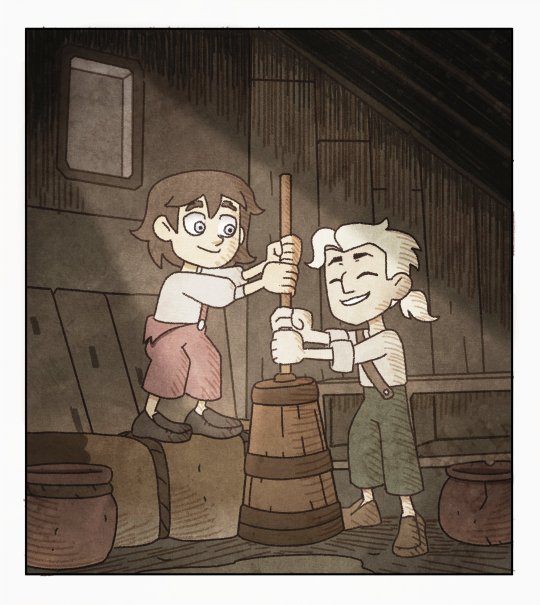
Philip’s pants are red and Calebs are green. While it is a myth that Puritans could only wear black, the colors that they were allowed to incorporate into their wardrobe were typically still neutrals (dark yellows and beiges). Green would be pushing it, and red would be unbelievably bold.

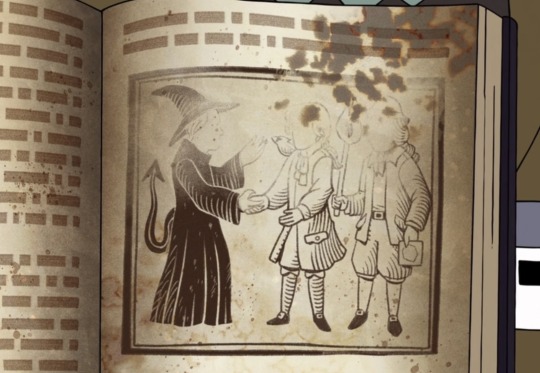
Additionally, the ruffles on Philip’s shirt in the journal and Jacob’s book, would have been seen as incredibly vain.



The blue/black coat that Caleb wore in the puppet show, and Philip later wears in Elsewhere and Elsewhen and King’s Tide has gold buttons and gold embroidery. Gold and Silver accessories of any kind would have been considered incredibly sinful and conceited.
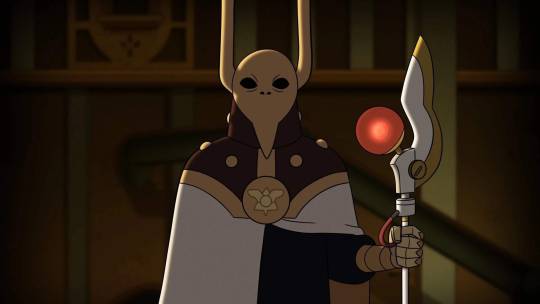
Which would also make it really weird for a Puritan to choose gold to represent himself. Infact his whole emperor authentic is much more reminiscent of the Catholic Pope. His own role as the messenger of the Titan’s will is also very papal in nature.
Finally there is the term he uses, “Witch Hunter General” is an illusion to “Witch Finder General” which was a rank made up and used by Protestant Matthew Hopkins and not really used by any Puritans. Such a title would also probably have seemed pretty vain.
Now you might say, “It’s a fictional story, why does any of this matter?”
The answer is: It does not, but I am high and have ADHD and this was the rabbit hole I fell down.
#the owl house#owl house#toh#wittebros#wittebane brothers#philip wittebane#caleb wittebane#witch trials#witch hunts#history#belos#emperor belos
574 notes
·
View notes
Text

Sanjulian - Original cover painting for Shudder #15, 2024
82 notes
·
View notes
Text
The first feminist to disinter the witches’ story and to claim this title for herself was the American Matilda Joslyn Gage, who fought for women's right to vote and also for the rights of Native Americans and the abolition of slavery—she was given a prison sentence for helping slaves to escape. In Woman, Church and State (1893), she offered a feminist reading of the witch-hunts: “When for ‘witches’ we read ‘women’, we gain fuller comprehension of the cruelties inflicted by the church upon this portion of humanity.” Gage inspired the character of Glinda, the good witch in The Wonderful Wizard of Oz, which was written by her son-in-law, L. Frank Baum. When he adapted the novel for cinema in 1939, Victor Fleming created the first "good witch" in popular culture.
-Mona Chollet, In Defense of Witches: The Legacy of the Witch Hunts and Why Women are Still on Trial
130 notes
·
View notes
Text
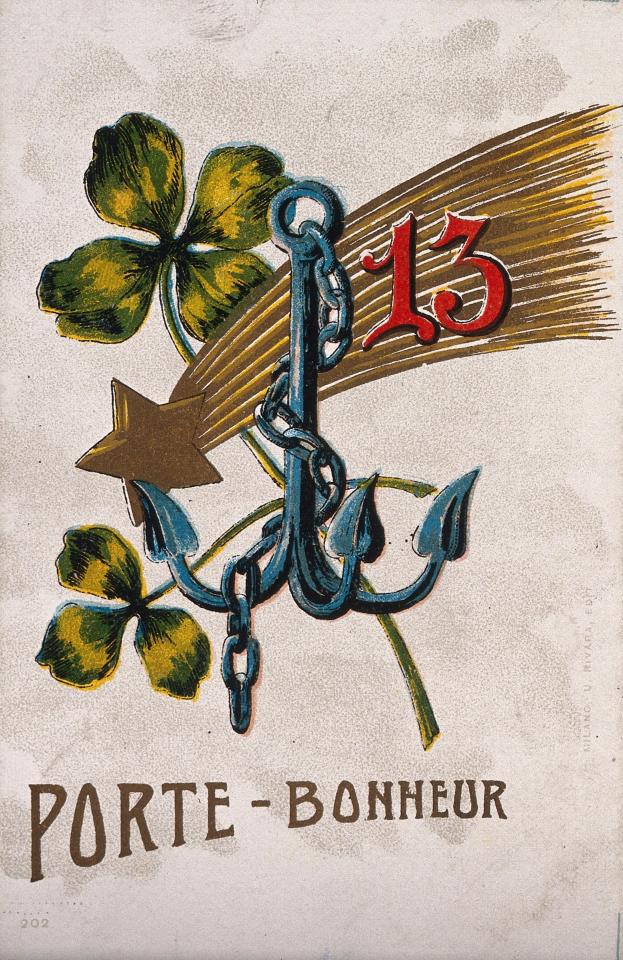
Feeling superstitious this Friday the 13th?
Superstitions, magic, and witchcraft have deep historical roots, spanning across cultures and civilizations. Rooted in the human quest to understand and control the mysterious forces of the world, these practices often involve rituals, symbols, and beliefs that go beyond the realm of empirical evidence.
Superstitions are often cultural traditions or irrational beliefs, while magic encompasses rituals and spells believed to harness supernatural powers. Witchcraft, historically associated with individuals, often women, who were thought to possess magical abilities, has a darker side marked by persecutions. The infamous witch trials, such as the European witch hunts of the 15th to 18th centuries, resulted in the persecution and execution of thousands.
Fear of the supernatural, religious fervor, and social tensions contributed to these dark chapters in history, underscoring the dangers of unchecked superstition and the persecution of those labeled as practitioners of magic or witchcraft.
Learn more on JSTOR in "Superstitions, Magic, and Witchcraft," an open access chapter from The Consistory and Social Discipline in Calvin's Geneva.
Image credit: A Postcard Wishing Good Luck Illustrated by Various Lucky Charms. Chromolithograph. From the Wellcome Collection on JSTOR.
#jstor#research#academic research#superstition#magic#witchcraft#calvinism#supernatural#witch hunts#good luck#friday the 13th#occult#folklore
125 notes
·
View notes
Text
The inability to except that Christians can, have, and do practice magic is more "Burning Times" bias and bullshit.
I personally think that some of you prefer the fantasy-esque style narrative of the witch trials; a people of a noble and nature centric belief system being systematically hunted down and killed by an evil empire. As opposed to the reality based narrative of the gender, race, and politcal struggle the witch trials actually represented.
How many times does it have to be said that a large part of the people killed identified as Christian? How many times does it have to be said that many of them weren't practicing anything?
Not Midwifery. Not Herbalism. Not Cunning Craft.
Nothing.
Some were accused simply for the sake of accusation. Accusation that could be used as a tool to exert political and religious power- or accusation simply because of unchecked panic and fear. Sometimes both.
If there is a generalized lesson one can take from the complexities of the witch trials, it's not "Witches were oppressed and killed by the church" but rather "The church and other political elites created a bogeyman so generic and pervasive in the psyche of the people they were meant to govern that people died, many of whom were "their own"."
It was a time and place in history where almost none were safe, and I personally think that's something we should unite under. Not use as a wedge to further drive us apart- or a means to label oneself as a "true heir" to witchcraft/magic while labeling others as "natural enemies" (like seriously, that's how some of you act and...yuck.)
#not christian#just like history#rant#magic#folk magic#spirituality#folklore#magic practitioners#ritual magic#witchblr#witchcraft#history#dialog#witch trials#witch hunts#'burning times'
451 notes
·
View notes
Text
People get the Witch Hunts all wrong

It is history-rant time. And today let me rant about one topic that just really gets me frothing at the mouth, because people will just mix up so many fucking things in this. And yeah, this is gonna be a long one. So strap in.
When it comes to the witch hunts, people are gonna have all sorts of ideas, that are just wrong. And today I wanna go and debunk some of them.
The myths for today:
The witch hunts were a medieval phenomenon.
The Spanish Inquisition was about witch hunts.
The witch hunts were about pegan religions.
Witches were all burned on the stake.
Witch hunts were all about women.
Actually, witch hunts established modern rights for defending yourself against accusations and were therefore good. (Yes. I heard that one.)
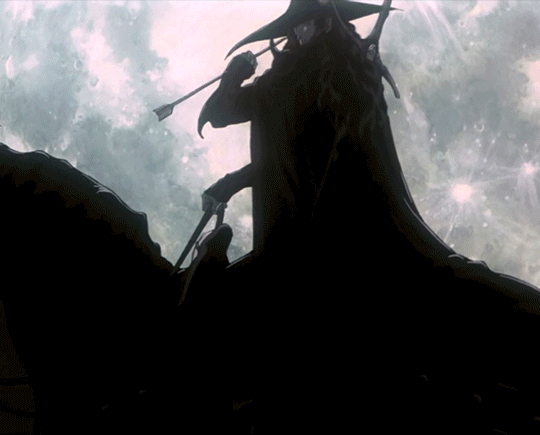
Myth 1: The Witch Hunts were a medieval thing.
I honestly do not know how often I have seen this one before. Like so many books and other media just keep harping on about this one. About the witch hunts happening in the middle ages. Which is just not true.
The middle ages are usually said to be 500 till 1500, though the most precide way to define them would be to say they lasted from 476 (the fall of the Roman Empire) till about the midth of the 15th century.
Meanwhile we also can argue exactly when the first witch was persecuted as such. Because there were people kinda persecuted for witchcraft, but actually executed for something else. But all in all the witch hunts started in the midth of the 15th century, aka, when the middle ages ended.
From there on there were witch hunts happening again and again all over Europe and later the US. It was not a constant thing that would happen every other week, but rather it would usually just hit an area like almost a collective mania. Then within a short time several people would be accused of witchcraft (often accusing each other) of which some would be executed. Then there would not be such a thing for several decades.
The reason, why witch hunts were not a thing of the middle ages, was that the church basically was not allowed to persecute crimes. And as the general society kinda saw magic as an in general more neutral thing, there were laws against black magic, but usually the punishment against those was not death.
And this changed in the 15th century, with the church getting more legal power.
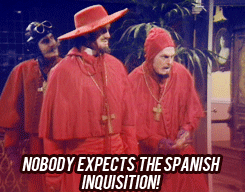
Myth 2: The Spanish Inquisition was a witch hunt.
One thing that I do not quite get how it happened... A lot of people just claim that the Spanish Inquisition was a witch hunt... Which it was not.
There really is not much to say here. The Spanish Inquisition happened after the Reconquista war, aka after the Christians reclaimed the Iberian peninsula from the Muslims, who were ruling Iberia for a long while. And because the Christians at the time were a lot worse when it came to living peacefully with other religions than the Muslims of the time, they went out and wanted to force the Muslims (and the Jews who had fled to Iberia because of persecution in the Christian areas of Europe) to either convert to Christianity - or be killed.
Yes, that kinda turned into another craze that ended with a ton more people dead in the end, as after a while people were hunted down for all sorts of things... It really was mostly about hunting down Muslims and Jews.
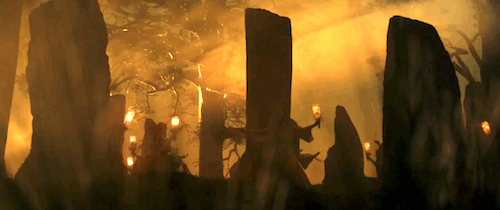
Myth 3: The witch hunts were all about pegan religions
With this myth I do know where it comes from. It comes from the neopagans, who usually have found their home with pegan religion within the last two generations, but love to claim that their family (especially their matrilinear line) totally always has been pegan, but they had to hide this because of the witch hunts. To be perfectly frank: This is mostly something that comes from white cis abled women, who desperately want to feel persecuted in some way.
But, yeah... I am not saying that there were no pegans killed during the witch hunts. Though of course the idea of keeping "pegans" as a different thing from Christians is kinda... complicated. Because for the most part in Europe it was not that Christianity totally extinguished the indigenous religions of whatever culture it took over, but rather supplemented it. This is super clear in Scotland and Ireland, but also in parts of Scandinavia.
A lot of those original religions have been lost, yeah. But... It was not quite how people imagine it to have gone when it comes to the conversion of people.
But in fact, the time this happened - the conversion of people towards Christianity and the pegan hunts that came with it - happened mostly between the 4th and the 8th century, so in the late Roman and early medieval period. And it was not what had happened in the witch trials.
The witch trials mostly went back to a very misogynist book of the "Malleus Maleficarum" - and to the church needing a good reason to get more power. It started out as: "Women are very corruptable. Satan has in fact corrupted so many women. Here is what you can do to find out whether a woman is a witch!" And from there it went to like: "Satan does want to corrupt us all! Everyone is corrupted by Satan!"
And a lot of it ended up being also directed against women, who held knowledge. Which was mostly connected to the entire push for more stricter patriarchal powers to come in. So, for example herbalists, who often taught their daughters, were often targeted, because they held knowledge and through that knowledge power. But also women in other positions of power.
And then... just everyone who was an inconvenience...
And disabled people...
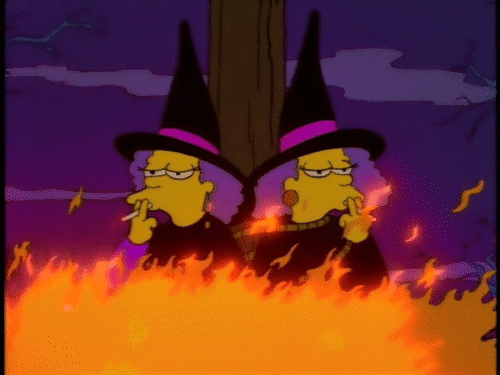
Myth 4: All the witches were burned on the stake.
Another thing that keeps getting iterated in media a lot is the idea of witches burning on the stake. Because... I guess it is a pretty big image as an influence.
But... actually a lot of witches were simply hanged or beheaded. It kinda depended on the area and whoever was responsible for the witch hunts there. France in general was big on the burnings. But large parts of England were bigger on the hanging. Here in Germany some were burned and beheaded. And some were hanged first with their bodies then burned.
In some areas it shifted over time.
Nothing much more to say about this one. If you wanna write about some witch hunts, you should look up how people were killed in the version of witch hunts were you are from.
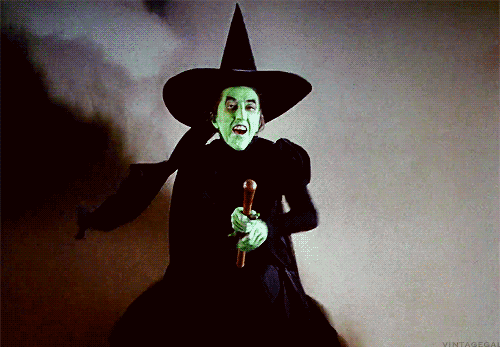
Myth 5: Witch Hunts only targeted women
As I said: Yes, the witch hunts definitely started with misogyny and was partly aimed at removing women from positions of influence and power. But they did not only target women. In fact in the end it was about equal with whom they targeted. In the end it was also highly dependend on the area. But... yeah. It is more complicated.
A just little fun fact: In Lichtenstein most of the "witches" killed were in fact men, because someone figured out that the entire "yeah, actually, we own the stuff the witch had owned" was way more profitable if you went for the men, who usually owned more things than women. Because patriarchy.
Another group that definitely was also targeted where people who were disabled or neurodiverse. Because they were often seens as being posessed by demons and such, due to people not understanding what was happening. This was especially true for people with turettes.
So, yeah. It started with misogyny and targeting women. But over the about 300 years during which most witch hunts happened, it shifted and spread from there.

Myth 6: The witch hunts gave us proper legal protocol
Okay, another one... This one I heard first from the father of my ex boyfriend, as he defended the bad things that had happened in the name of the church. But I have heard it several times since, so I think it is worth adressing.
The idea goes like this: "Well, actually during the witch hunts they introduced those neat legal concepts. Like, you could not be tortured more than three times, you were allowed to have a defendend and you could not be charged with the same crime twice! So it totally brought us modern legal practice!" Which... like...
*deep sigh* Honestly, that this has to be said. But... No.
First of all: Actually those things predate the witch hunts. And in fact torture was a thing that was not permitted as a form of interrogation in many areas where it became permitted during the witch hunts. Not saying it was not used as such still, just that it technically was not permitted. Just as the people just didn't give a flying fuck during the witch hunts on the legal limitations they had on the torture. People would often be tortured a) more than three times, b) for longer than allowed and c) with the kind of permanent injury that the law did not in fact allow. Because people did not care in the end. Same with the other things. And if you got a defendend, that defendend was not always on your side.
And, again, all those concepts predate the witch hunts. They were not universal, no. But they were not invented during the witch hunts.
So... Christ. If you really want to defend the senseless killing of people based on a made-up crime... Then at least think of some actual facts to defend it, rather than making shit up.
(Also I think this myth comes from history channel.)
So, yeah... That are some myths about the witch hunts that I have encountered several times. Are there some I missed?
#history#history rant#well actually#myths#historical myths#witch hunts#witch burning#medieval history#early modern history#early modern period#rant
75 notes
·
View notes
Text
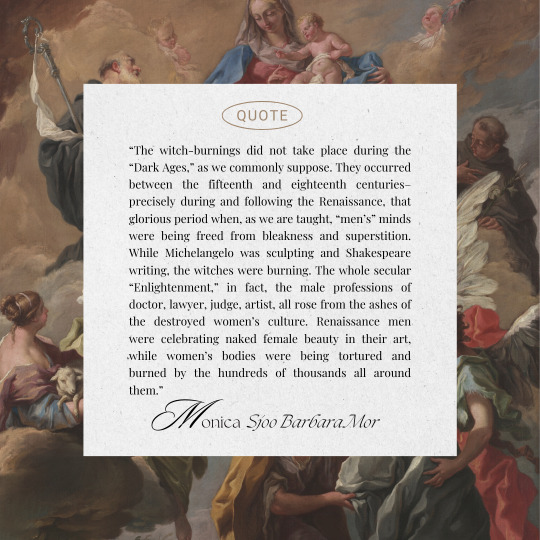
89 notes
·
View notes
Text
It frustrates me because certain people glamourise what must have been terrifying and awful experiences for very isolated and powerless people.
It was more “I want your house and you were mean to me once and you’re disabled/old/foreign so I’m using the current shitshow to get even.”
163 notes
·
View notes
Text
Check your conspiracy theory part two: double, double, boil and trouble
Does your conspiracy theory sound something like this?
There is a large number of people who practice a form of religion that demands animal and human sacrifices.
Their practices can be traced all the way back to ancient times.
They are responsible for many mysterious murders, disappearances, and animal deaths.
They especially prey on children, or require children for certain rituals.
Their rituals include immoral sexual activities.
They practice ritual cannibalism.
They use something from the victims' bodies for medicinal or mystical purposes.
They regularly cast curses.
They have special means of manipulating or controlling people's minds.
Strange medical and psychological symptoms are evidence that one has been targeted or tortured by these people.
Their rituals and holidays are viscerally disgusting mockeries of normal, wholesome rituals and holidays. Feces, urine, and blood are often involved.
Members are severely punished (physically and psychologically) for transgressions.
Members are frequently driven to suicide.
Members often lead double lives, often seeming to be good law-abiding citizens to the public.
There are numerous telltale signs that give their allegiance away; EG, strange body markings or owning things that could be used in rituals.
If evidence can't be found, it's because they have ways of hiding it.
They have ways of traveling and transporting victims to seemingly improbable locations with no one noticing.
They might believe themselves to be worshiping pagan gods, but it's actually a satanic deception.
All of these claims go back to early modern witch panic and blood libel. (There is significant overlap between these things.) You can find this kind of stuff claimed in literature like the Malleus Malificarum, A Discovery of Witches (the one by Matthew Hopkins), and the Compendium Maleficarum. You can also find information on the history of blood libel over here.
#conspiracy theories#conspiracy theory#conspiracism#witch panic#witch hunt#witch hunts#antisemitism#satanic panic#nwo#new world order#illuminati#the illuminati#one world government
998 notes
·
View notes
Note
I am honestly surprised that nobody thought of using the German fairy tale Hänsel und Gretel today to talk about the real historical violence caused by Witch Hunts and Witch Trials.
I suppose any fairy tale with an evil witch could be used to talk about historic witch hunts and witch trials. But maybe Hansel and Gretel would suit that purpose especially well. Accusations of harming children were always a powerful tool against "witches" (and Jews and other minorities, for that matter), and the witch in the story dies by burning, which was the common method of execution.
Still, people probably don't want to look at Hansel and Gretel that way because they love the story. It's a nostalgic childhood favorite and they don't want to think of how it might perpetuate tropes that historically killed people.
17 notes
·
View notes
Note
I'm writing a wittebane's fanfiction and I can't find anything about how old one had to be in order to join witch hunts. It's just all about the victims--which is important don't get me wrong but I can hardly find anything on the witch hunters end other then the famous guys like Hopkins. Was their ever a recording of a specific age requirement to join the witch hunts?
Well, the thing is witch hunting was not a formal profession. Unless you're Matthew Hopkins who managed to make a career out of it, witch hunters could be anyone with a lot of time, resources, and the ability to draw out false confessions (i.e. torture). Witchcraft was considered to be a felony punishable by death so any "witch-hunters" would be people like politicians, local magistrates, lawyers, ministers, basically anyone in a position of power. It would be their job to investigate accusations of witchcraft (perjury was also a crime so there had to be sufficient "evidence") and then proceed to put the accused on trial, witness would then come in with their evidence, and the court would decide the accused's fate.
The image of a lone witch hunter moving from town to town looking for witches is largely inspired by Hopkins. For the most part, witch hunts were communal: neighbors would accuse neighbors, rival families would target each other, and god help you if you were a slave or a woman with a sharp tongue, then everybody would come after you. It also didn't matter what age you were if you wanted to accuse someone of witchcraft; Betty Parris and Abigail Williams, whose strange fits and outbursts kickstarted the whole Salem Witch Trials, were aged 9 and 11 respectively.
It is also important to remember that witch hunts typically happen during times of great turmoil, Hopkins rose to power during the English Civil War and Salem's witch hunts occurred years after the disastrous King Philip's War which led to more refugees populating the region. There are, of course, a variety of complex reasons why witch hunts happen but they do not happen when a population is fed, healthy, and happy.
During times of crisis, anyone in a position of power can be a self-appointed "witch-hunter" and start a campaign targeting the community's most vulnerable members.
#asks#history#witch hunts#salem witch trials#witchcraft#matthew hopkins#colonial america#american history#the owl house
28 notes
·
View notes
Text
Personally, I do believe in the possibility that there could have been some self identified witches who were executed during the witch hunts.
The other 99%, either confessed to witchcraft in the hopes of being spared for recanting, or denied the accusations to the pyres and gallows.
41 notes
·
View notes
Text
It has taken me a surprisingly long time to appreciate the degree of misunderstanding within this magnet for fantasy, this image of a heroine with superpowers—as witches are portrayed in all dominant cultural productions going. Half a lifetime to understand that, before becoming a spark to the imagination or a badge of honor, the word "witch" had been the very worst seal of shame, the false charge which caused the torture and death of tens of thousands of women. The witch-hunts that took place in Europe, principally during the sixteenth and seventeenth centuries, occupy a strange place in the collective consciousness. Witch trials were based on wild accusations of night-time flights to reach sabbath meetings, of pacts and copulation with the Devil—which seem to have dragged witches with them into the sphere of the unreal, tearing them away from their genuine historical roots. To our eyes, when we come across her these days, the first known representation of a woman flying on a broomstick, in the margin of Martin Le Franc's manuscript Le Champion des dames (The Champion of Women, 1441-2), appears unserious, facetious even, as though she might have swooped straight out of a Tim Burton film or from the credits to Bewitched, or even been intended as a Halloween decoration. And yet, at the time the drawing was made—around 1440–she heralded centuries of suffering. On the invention of the witches sabbath, historian Guy Bechtel says: "This great ideological poem has been responsible for many murders." As for the sexual dimension of the torture the accused suffered, the truth of this seems to have been dissolved into Sadean imagery and the troubling emotions that provokes.
In 2016, Bruges' Sint-Janshospitaal museum devoted an exhibition to "Bruegel's Witches," the Flemish master being among the first painters to take up this theme. On one panel, he listed the names of dozens of the city's women who were burned as witches in the public square. "Many of Bruges' inhabitants still bear these surnames and, before visiting the exhibition, they had no idea they could have an ancestor accused of witchcraft," the museum's director commented in the documentary Dans le sillage des sorcières de Bruegel. This was said with a smile, as if the fact of finding in your family tree an innocent woman murdered on grounds of delusional allegations were a cute little anecdote for dinner-party gossip. And it begs the question: which other mass crime, even one long past, is it possible to speak of like this—with a smile?
By wiping out entire families, by inducing a reign of terror and by pitilessly repressing certain behaviors and practices that had come to be seen as unacceptable, the witch-hunts contributed to shaping the world we live in now. Had they not occurred, we would probably be living in very different societies. They tell us much about choices that were made, about paths that were preferred and those that were condemned. Yet we refuse to confront them directly. Even when we do accept the truth about this period of history, we go on finding ways to keep our distance from it. For example, we often make the mistake of considering the witch-hunts part of the Middle Ages, which is generally considered a regressive and obscurantist period, nothing to do with us now—yet the most extensive witch-hunts occurred during the Renaissance: they began around 1400 and had become a major phenomenon by 1560. Executions were still taking place at the end of the eighteenth century—for example, that of Anna Göldi, who was beheaded at Glarus, in Switzerland, in 1782. As Guy Bechtel writes, the witch "was a victim of the Moderns, not the Ancients."
Likewise, we tend to explain the persecutions as a religious fanaticism led by perverted inquisitors. Yet, the Inquisition, which was above all concerned with heretics, made very little attempt to discover witches; the vast majority of condemnations for witchcraft took place in the civil courts. The secular court judges revealed themselves to be "more cruel and more fanatical than Rome" when it came to witchcraft. Besides, this distinction is only moderately useful in a world where there was no belief system beyond the religious. Even among the few who spoke out against the persecutions such as the Dutch physician Johann Weyer, who, in 1563, condemned the "bloodbath of innocents"—none doubted the existence of the Devil. As for the Protestants, despite their reputation as the greater rationalists, they hunted down witches with the same ardour as the Catholics. The return to literalist readings of the Bible, championed by the Reformation, did not favor clemency—quite the contrary. In Geneva, under Calvin, thirty-five "witches" were executed in accordance with one line from the Book of Exodus: "Thou shalt not suffer a witch to live" (Exodus 22:18). The intolerant climate of the time, the bloody orgies of the religious wars—3,000 Protestants were killed in Paris on St. Bartholomew's Day, 1572–only boosted the cruelty of both camps toward witches.
Truth be told, it is precisely because the witch-hunts speak to us of our own time that we have excellent reasons not to face up to them. Venturing down this path means confronting the most wretched aspects of humanity. The witch-hunts demonstrate, first, the stubborn tendency of all societies to find a scapegoat for their misfortunes and to lock themselves into a spiral of irrationality, cut off from all reasonable challenge, until the accumulation of hate-filled discourse and obsessional hostility justify a turn to physical violence, perceived as the legitimate defense of a beleaguered society. In Françoise d'Eaubonne's words, the witch-hunts demonstrate our capacity to “trigger a massacre by following the logic of a lunatic.” The demonization of women as witches had much in common with anti-Semitism. Terms such as witches "sabbath" and their "synagogue" were used; like Jews, witches were suspected of conspiring to destroy Christianity and both groups were depicted with hooked noses. In 1618, a court clerk, whiling away the longueurs of a witch trial in the Colmar region, drew the accused in the margin of his report: he showed her with a traditional Jewish hairstyle, "with pendants, trimmed with stars of David."
Often, far from being the work of an uncouth, poorly educated community, the choice of scapegoat came from on high, from the educated classes. The origin of the witch myth coincides closely with that—in 1454–of the printing press, which plays a crucial role in it. Bechtel describes a "media campaign" which "utilized all the period's information vectors": "books for those who could read, sermons for the rest; for all, great quantities of visual representations." The work of two inquisitors, Heinrich Kramer (or Henricus Institor) from Alsace and Jakob Sprenger from Basel, the Malleus Maleficarum was published in 1487 and has been compared to Hitler's Mein Kampf. Reprinted upward of fifteen times, it sold around 30,000 copies throughout Europe during the great witch-hunts. "Throughout this age of fire, in all the trials, the judges relied on it. They would ask the questions in the Malleus and the replies they heard came equally from the Malleus." Enough to put paid to our idealized visions of the first uses of the printing press! By giving credence to the notion of an imminent threat that demanded the application of exceptional measures, the Malleus Maleficarum sustained a collective delusion. Its success inspired other demonologists, who became a veritable gold mine for publishers. The authors of these contemporary books—such as the French philosopher Jean Bodin—whose writings read like the ravings of madmen, were in fact scholars and men of great reputation, Bechtel emphasizes: "What a contrast with the credulity and the brutality demonstrated by every one of them in their demonological reports."
-Mona Chollet, In Defense of Witches: The Legacy of the Witch Hunts and Why Women are Still on Trial
#mona chollet#witch hunts#womens history#printing press#female oppression#male violence#anti semitism#misogyny#european history
31 notes
·
View notes
Text
Self Promotion
In this a fanfiction written by myself and @chiconisroc. In it, Philip is transported to the past after his death at the end of The Owl House. There, he finds that the past version of himself perished some years before due to an illness and Caleb has been made the apprentice of the minister and a local witch hunter. Now, Philip must adapt to being on the other side of his own ideals and ally himself with someone he hated.

Summary: Philip, stuck in his cursed form, believed he had died after his fight with Luz, but instead life brings him back to the 1600's on Earth, finding an unlikely ally with a witch he despises and his older brother hunting him down
I made the art for the cover.
The Minister and the townsfolk are all OCs.
#Philip Wittebane#Philip Wittebane redemption#Evelyn Clawthorne#Caleb Wittebane#past Gravesfield#Caleb x Evelyn#The Owl House#Owl House AU#Caleb is a witch hunter#Witch hunts
42 notes
·
View notes
Text
Some thoughts on Witches and Environmentalism and The Church
ok so I've been thinking about the history of paganism and witchcraft and I have some semi-formulated semi-researched thoughts that I need to get out of my head. please feel free to discuss or make corrections because i am diving head-first into this hyperfixation and I CRAVE KNOWLEDGE THANK YOU
- witches were the first environmentalists
- different values in paganism vs Christianity regarding the earth and nature (value and respect for nature vs control and harnessing it for the benefit of the people)
- and then the witch hunts happened (aka, the people in the world that cared the most about the natural world were killed)
- then the industrial revolution happened, and THEN people started realising (re-realising?) that we were very actively killing our planet
8 notes
·
View notes